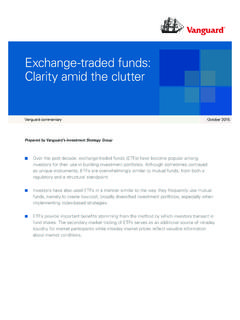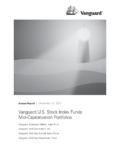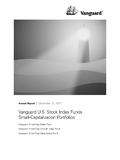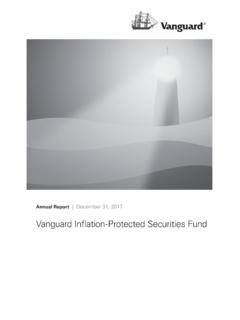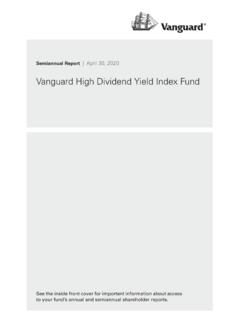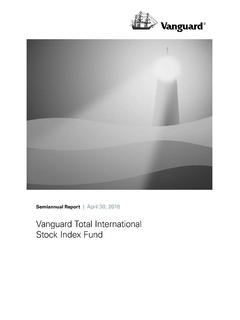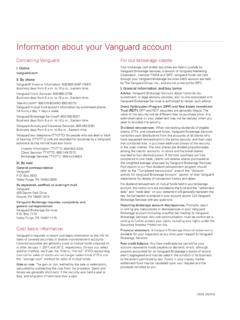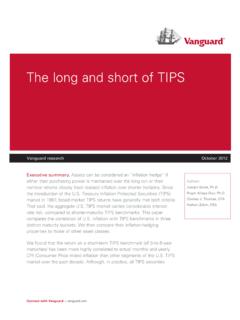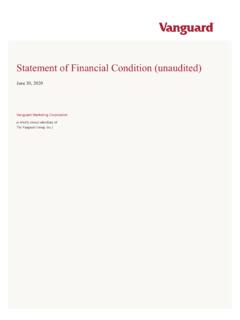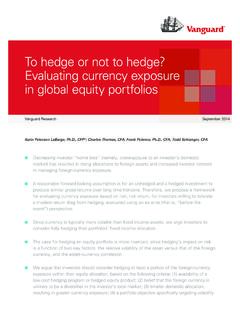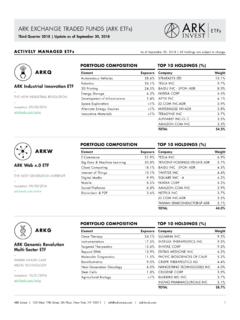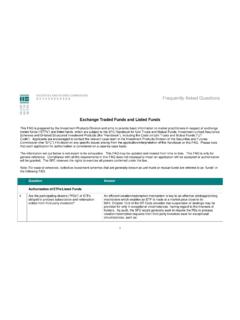Transcription of The buck stops here: ‘Best practices’ for ETF trading ...
1 exchange - traded funds (ETFs) effectively blend the investment characteristics of mutual funds with the trading flexibility of individual securities. ETFs trade somewhat differently than either mutual funds or individual securities, and investors may need to learn different tools and strategies when trading ETFs. Unlike investing in mutual funds, for example, investors generally bear the full costs of trading ETFs in their personal transactions. This paper outlines ETF trading best practices that emphasize price control and patience in trading . Three of the key best practices discussed for individual investors who trade ETFs are: (1) avoid the use of market orders instead, consider using marketable limit orders (see box of key terms on page 4); (2) avoid trading at either the market open or close; (3) for larger orders, consider phoning your brokerage firm for additional sources of liquidity to reduce transaction costs.
2 Joel M. Dickson, ; James J. Rowley Jr., CFAThe buck stops here : Vanguard money market fundsVanguard research June 2014 best practices for ETF trading :Seven rules of the roadExchange- traded funds have become an increasingly popular investment vehicle over the past decade. Generally speaking, ETFs blend the investment characteristics of a mutual fund with the trading flexibility of individual securities. These key attributes introduce differences in how ETFs trade relative to both mutual funds and individual securities, as well as in the approach investors may wish to take in trading them.
3 This paper highlights the trading differences of these investment vehicles. Understanding these differences helps to underscore why incorporating a set of ETF trading best practices that emphasize price control and patience in trading can help reduce both the implementation risks of ETFs and their transaction costs. trading ETFs versus mutual funds and individual securities ETFs are very similar to mutual funds. Both vehicles can provide low-cost exposure to investment strategies, and both calculate a net asset value (NAV) based on the value of their underlying securities at 4 , Eastern time, each trading day.
4 However, due to the differences in the trading characteristics of ETFs versus mutual funds (see Figure 1), investors should learn how to use different tools to trade ETFs proficiently. 2 Note on risk: All investing is subject to risk, including the possible loss of the money you 1. Mutual funds have different trading characteristics than ETFs and individual stocksTrading characteristicsMutual fundETF and individual stocksWhen is a trade executed?Regardless of when a trade is placed, it is executed at a specified time (usually 4 , Eastern time) directly with the mutual market hours on an exchange , either immediately (market order) or when a stipulated trade price is met (limit order).
5 See Note, of a market does the trade settle?Next business business unitsDollars (usually). : Some investors may be able to execute trades outside of normal market : 2 illustrates that ETFs trade somewhat differently than mutual funds and stocks. Mutual fund investors buy and sell fund shares directly with the mutual fund . In contrast, most ETF investors do not trade directly with the ETF. Rather, designated institutions known as authorized participants (APs) work with the ETF to create and redeem ETF shares as needed. APs work as intermediaries between the ETF and investors to facilitate trading by increasing or decreasing the number of ETF shares outstanding in the market, to meet investor demand and keep the ETF s market price close to the value of the ETF s underlying securities.
6 Although ETFs trade on a stock exchange , they do not always trade like equities. The price and liquidity of an individual stock are largely determined by supply and demand, because the number of a stock s shares outstanding in the market is generally fixed. However, an ETF s market price and liquidity are determined by the ETF s underlying securities as well as by factors of supply, demand, and costs in the market (Dickson, 2013). 3 Figure 2.
7 Differences between trading ETFs versus mutual funds and individual stocks Mutual fundsMutual fundsInvestor AInvestor BIndividual stocksStocksMarket maker(on an exchange )Investor AInvestor BETFsAP/market maker(on an exchange )Investor AExisting ETF sharesInvestor BRetire ETF shares( Redemption )Issue ETF shares( Creation )ETFBuySellNotes: The ETF creation and redemption process is the means by which authorized participants bring new ETF shares into and out of the market, helping to maintain a balance between supply and demand. APs (authorized participants) can also act as market makers, but not all market makers are authorized : trading best practices By incorporating a set of ETF trading best practices , an investor may improve his or her trading process through more purposeful execution at a fair market price in relation to the value of the ETF s underlying securities.
8 In many situations, executing ETF trades in a price-controlled and patient manner can reduce transaction costs. Adhering to these basic principles can help ensure that an investor s execution price is as close to real-time value as possible when making ETF trades (The Vanguard Group, 2014).1. In general, use marketable limit orders instead of market orders. Marketable limit orders offer advantages over market orders in terms of price control and protection, while providing some trading flexibility. They are a form of limit order that may offer a higher likelihood of execution. For example, a limit order with a purchase price set in between the bid and ask has less chance of completion than a marketable limit order that is set to buy at the ask price.
9 Although a market order may be effective when dealing with highly liquid ETFs, there is always a risk of poor execution. As Figure 3 shows, beyond the best bid and ask price quotes is the remaining book of standing limit orders to sell to buyers at higher asks and to buy from sellers at lower bids. A market order runs the risk of sweeping indiscriminately through this book of liquidity, potentially leading to higher trading costs. A marketable limit order, however, sets a boundary around the price at which an investor is willing to transact. The higher the limit price for a buy (and the lower the limit price for a sell), the greater the probability that the trade will be executed.
10 The trade-off of garnering a greater likelihood of a fully completed trade, though, can be higher transaction costs. 4 The language of ETF trading : Some key termsBid-ask spread. The difference between the price a buyer is willing to pay (bid) for a security and the seller s offering (ask) price. The bid-ask spread represents the best bid and the best offer (the latter term is typically used in place of ask in exchange trading ). Because secondary-market (see definition below) transactions occur at market prices, you may pay more than the value of the underlying securities when you buy ETF shares, and receive less than the underlying securities value when you sell those premium/discount.
